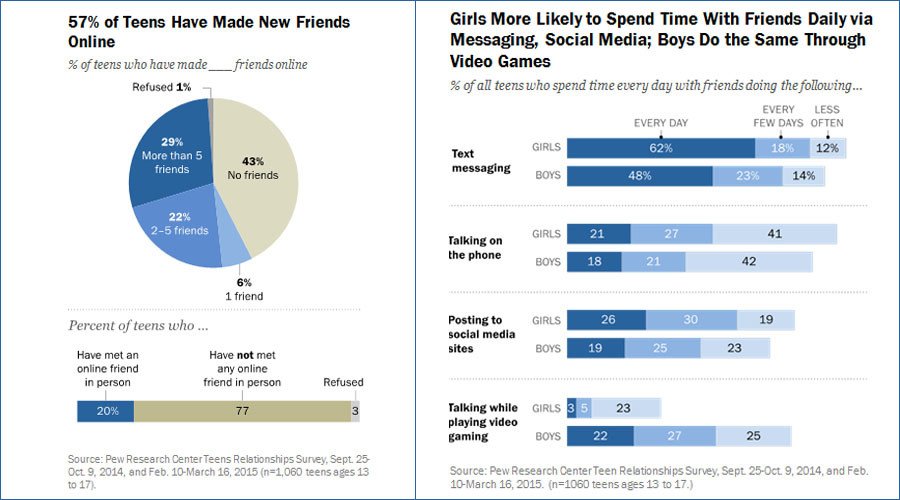Digital buddies: Teens prefer to make and keep friendships online rather than offline – study

Teenagers increasingly rely on electronic devices and the internet to maintain ties with friends. They also meet new buddies online, but rarely make new relationships in the real world, a new study says.
More than a half of the 1,060 teens surveyed in the latest Pew Research Center project had found at least one friend online. Fifty-seven percent of American children between 13 and 17 said they have made a friend online with almost three out of ten (29 percent) claiming to having palled up with more than five other teens on the internet.
The overall majority of these new friendships never transformed into real life meetings as 77 percent of those questioned had never seen their online peers in person, the Pew researchers say in their study published on Thursday.
“We found the internet is really a critical part of how teens make and sustain friendship,” said Amanda Lenhart, associate director of research at Pew. “It helps us unpack some adult assumptions – that they’re wasting time with these devices.”
READ MORE:Sexed-up social media damaging girls’ mental health, study suggests
Social networks appear to be the most popular places for making friends as almost two-thirds (64 percent) of teenagers who made friends online did it via a social media site.
Eight out of ten teens taking part in the research said that Facebook and Instagram helped them to be more involved in their peers’ lives while a little under three quarters of respondents claimed social networks let them share their friends’ feelings.
Girls usually rely more than boys on social networks in their communication as well as in a search for new friends by chatting online or posting something. They form online communities to discuss common interests more often than their male counterparts.
Additionally, they are more likely to block or unfriend people after a relationship breakup.
READ MORE:Using Facebook to spy on your ‘friends’ can cause depression – study
Boys, in turn, more often make friendships via online games with more than a half of them claiming to have made new friends while playing compared to only 13 percent of girls. Additionally, boys are generally more likely to make friends online as 61 percent of them did so versus 52 percent of girls.
More than three quarters of teenagers playing online games say it helps them to be more connected to their friends as they play together. For boys, this factor is more important as 84 percent of them claim to “feel more connected to friends” while playing compared to 62 percent of girls.

Boys also spend more time playing with pals than girls with 16 percent of them gaming with friends every day versus only 5 percent of girls.
“Communication in games really grew over the past 10 to 15 years,” said David Cole, founder of DFC Intelligence, a company that researches digital media, as quoted by the New York Times. “It was games like World of Warcraft and Xbox Live, with products like Halo that really drove it for teens.”
READ MORE:Social media, internet stealing valuable sleep time from US teens
Although teens use a wide range of platforms and devices to be in touch with peers, text messaging is still the most commonly and frequently used means of communication. Fifty-five percent say that they communicate via text daily, while only 25 percent meet their friends in person every day.
Instant messages and phone calls are also popular, especially in relations between close friends, while video chatting and email tend to be the least commonly used communication tools.
Despite a constantly growing reliance by teens on online communication, this experience is not always pleasant for them. Sixty-eight percent of survey respondents claimed to have overcome a drama among online friends with around a quarter having confronted a friend in real life because of something initially happened in the internet.
Girls are involved in digitally facilitated conflicts more often (32 percent) than their male counterparts (20 percent). Similarly, whites also are more likely to engage in these type of conflicts than blacks.
Additionally, teens often experience psychological pressure imposed by online communication as they feel like they have to post only content that makes them look good (40 percent) or be popular (39 percent).












